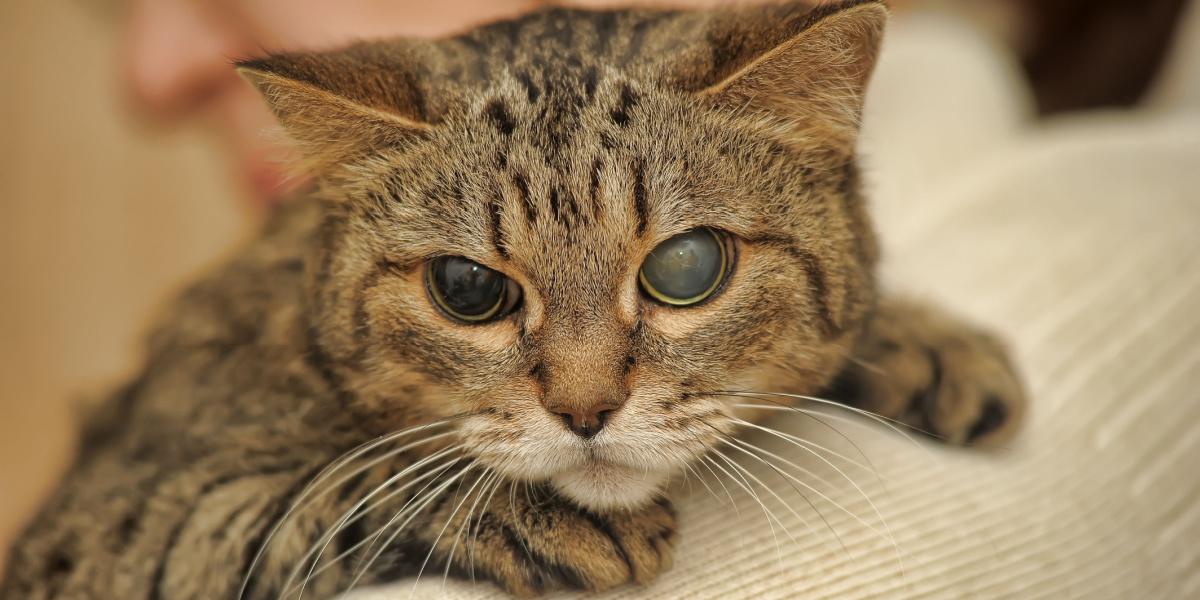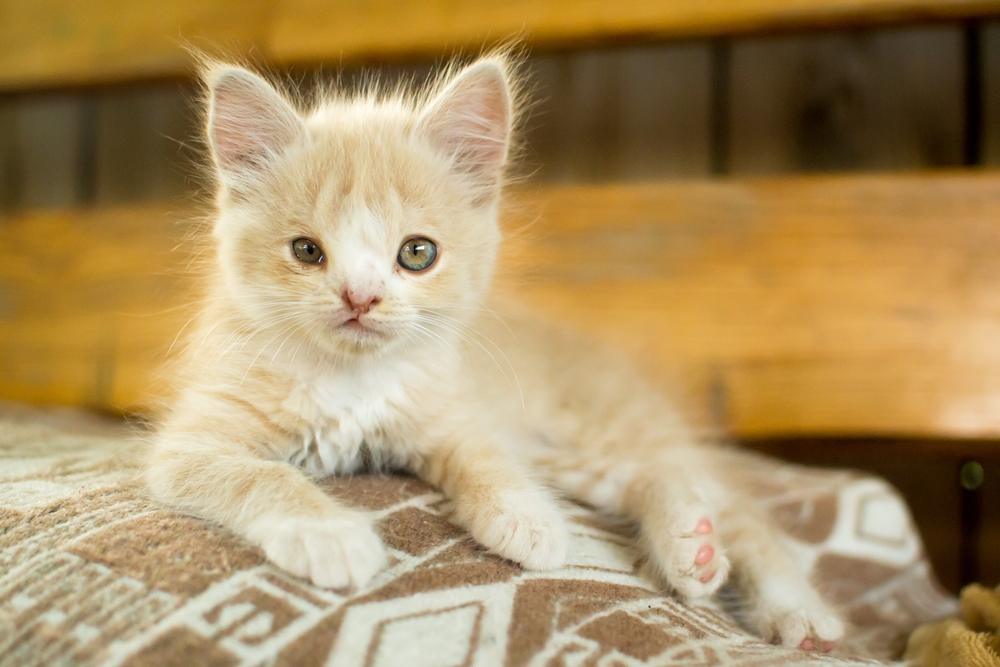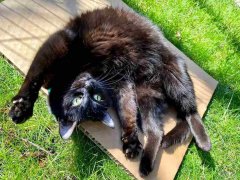
Taurine is an amino acid that cats uniquely require in their diet to stay healthy. In this article, you’ll learn what taurine is and what it’s needed for, what happens when cats don’t get enough of it, how taurine deficiency in cats is treated, and some frequently asked questions.
Quick Overview: Taurine Deficiency in Cats





What Is Taurine?
Taurine is an amino acid. Amino acids are the building blocks that make up proteins. There are two main categories of amino acids, essential and non-essential.
- Essential amino acids are ones that our bodies cannot make, so we must obtain them in our diet. Some common examples of essential amino acids include lysine and methionine.
- Non-essential amino acids are ones that we can synthesize on our own. Examples include arginine and cysteine.
For humans, taurine is called a conditionally essential amino acid. This means that at most times, we make enough of our own to meet our needs, but at certain times, especially when the body is ill or under stress, we might need to consume more to meet our needs.
But cats by contrast cannot make enough taurine on their own and always need to consume it in their diet to meet their needs. For cats, this makes taurine an essential amino acid. Why can humans make taurine and cats can’t? Cats have a limited amount of the enzyme required to craft taurine out of cysteine, a non-essential amino acid. Cats also cannot store very much taurine in their bodies.
If cats need to get taurine in their diet, what foods are rich in taurine? Largely, we’re talking about meat, or animal protein. This includes red meat, white meat, fish, and dairy. Of those, dairy has the least taurine while red meat has the most. Plants have little to no taurine content.
Taurine is required by the body for a number of important things. These include:
- Vision
- Heart muscle function
- Digestion
- Maintaining pregnancy and fetal development
- Immune function
- Regulating minerals like calcium and other electrolytes
Causes of Taurine Deficiency in Cats
Because cats require taurine in their diet, consuming a diet that does not contain enough taurine is main cause taurine deficiency in cats.
Foods that do not contain enough taurine for cats include:
- Dog/canine diets
- Home cooked diets
- Vegetarian or vegan diets
- Human foods like baby foods
Many diets formulated for dogs contain animal-based proteins, so they do have some taurine in them. However, the amounts are not nearly high enough to meet a cat’s needs. Dogs are able to make their own taurine, so their diets are not supplemented with additional taurine (commercial cat diets are supplemented with more taurine).
In a study from 2019, researchers found that of 114 homemade diet recipes, none of them met all nutritional allowances for essential nutrients for cats. This simply supports the idea that home cooking for cats is not easy to do correctly, even with “good” recipes. Deficiencies in nutrients like taurine are a risk.
A strictly vegetarian or vegan diet is not natural or appropriate for cats, which are obligate carnivores and require animal protein in their diets. Their need for taurine, found only in animal protein, is just one example of why vegetarian or vegan diets are not natural for cats.
For cats with decreased appetites, trying things like baby food to encourage appetite is common. However, cats that are consistently eating too much of foods like this instead of proper cat foods will be at risk of a taurine deficiency.
In the 1980s, the connection between taurine deficiency and certain diseases was discovered. Taurine was recognized as an essential nutrient for cats and diet formulations were changed to include taurine supplementation.
Contemporary quality commercial diets for cats are supplemented properly with taurine, as long as they meet guidelines set forth by the Association of American Feed Control Officials (AAFCO). To meet AAFCO guidelines for taurine, cat dry foods must contain 25 milligrams per 100 kilocalories of food. For canned foods, the requirement is 50 milligrams per 100 kilocalories of food.
Also Read: When & How To Switch From Kitten To Cat Food
Symptoms of Taurine Deficiency in Cats

Taurine deficiency during pregnancy can lead to birth defects in the kittens.
The signs and symptoms of taurine deficiency in cats can take a few months to be recognized. Because taurine is involved in several body systems and processes, several manifestations of taurine deficiency might be seen. To make things easier, we’ll look at the health conditions taurine deficiency causes and signs seen with those disorders.
- Dilated cardiomyopathy (DCM): This is a type of heart disease where the cat’s heart gets larger while the heart muscle walls get thinner. Prior to 1987 when a connection between taurine deficiency in cats and DCM was made, this was the most common type of heart disease seen in cats (currently hypertrophic cardiomyopathy, or HCM, is most common).
- Cats with DCM, as with any heart disease, can show exercise intolerance, syncopal/fainting episodes, lethargy, and weakness. Signs of heart failure can include poor appetite, increased breathing effort and rate, and open-mouth breathing.
- Feline central retinal degeneration (FCRD): The retina is the back part of the eye that helps to transform absorbed light into vision. Taurine deficiency contributes to progressive blindness as the retina incurs damage.
- Reproductive disorders: Queens deficient in taurine will have difficulty getting pregnant and maintaining a healthy pregnancy. Kittens might be unthrifty with low birth weights.
- Birth defects: Kittens born to taurine-deficient queens are more prone to various birth defects, some of which will prevent them from making it to full term.
- Delayed growth in kittens: Kittens eating a taurine-deficient food or kittens that are nursing from a queen deficient in taurine will have trouble gaining weight normally.
- Digestive disorders: Taurine is a required part in the formation of bile salts. Bile is required for digestion of fats in the small intestine. Diarrhea and poor absorption of nutrients can occur in cats with taurine deficiency.
- Increased risk of diabetes: Taurine deficiency is not a leading cause of diabetes and is not considered a leading suspicion in most cats who develop diabetes. However, cats that are deficient in taurine are thought to have an increased risk of developing diabetes because of taurine’s role in assisting with blood sugar regulation.
- Weak muscles: Taurine deficiency can contribute to poor muscling and tone. This can lead to weakness and exercise intolerance.
- Immune system disorders: Cats with low taurine levels might be more susceptible to illness or have a harder time overcoming one.
- Electrolyte disorders: Poor electrolyte balance can contribute to weakness and dehydration. Problems with calcium regulation can contribute to heart arrhythmias, problems with bone remodeling, and disease of a cat’s teeth. Taurine also has a neuroprotective effect on nerve cells that can be compromised with deficiencies, contributing to neurodegenerative effects.
Complications of Taurine Deficiency
Of all the disorders seen with taurine deficiency in cats, the ones with the most recognized impact are dilated cardiomyopathy and retinal degeneration. Over time, these disorders are the most commonly seen and cause the greatest complications to health.
If not diagnosed and treated, cats with DCM will either develop a life-threatening heart arrhythmia or progress to congestive heart failure, which is a medical emergency and can have a guarded prognosis.
Feline central retinal degeneration will lead to progressive, irreversible blindness. Diagnosing taurine deficiency is crucial to putting a halt in the process salvaging what vision remains.
Diagnosis of Taurine Deficiency in Cats
Diagnosing taurine deficiency itself is usually a combination of the following:
- Recognizing that one or more diseases seen with taurine deficiency is present
- An accurate patient history that points to a diet deficient in taurine
- Bloodwork to check blood taurine levels
In many cases, taurine deficiency might not be suspected until a cat presents to a veterinarian with symptoms seen with this nutritional disorder. This is especially the case with DCM and FCRD, since both conditions are considered very rare unless taurine deficiency is involved.
During an exam, your vet may detect abnormalities to your cat’s heart, like a heart murmur or arrhythmia. When performing an eye exam, your vet will be able to have a basic look at the retina at the back of the eye to screen for abnormalities.
During your cat’s exam, your veterinarian might recommend some baseline diagnostics to get preliminary information and rule out other potential causes. These include:
- Comprehensive bloodwork
- Urinalysis
- Chest x-rays
- Ultrasound
Cats with taurine deficiency might have normal bloodwork and urinalysis, which might prompt a vet to additionally check blood taurine levels if taurine deficiency is suspected.
X-rays of the chest might show an enlarged heart if DCM is present.
Getting a definitive diagnosis for DCM and FCRD might require referral to a specialist, especially since these conditions are uncommon to see unless taurine deficiency is present.
A veterinary cardiologist specializes in heart disorders. A veterinary ophthalmologist specializes in vision disorders. Some ways these specialists can diagnose these disorders using testing not commonly available to general practitioners include:
- Dilated cardiomyopathy (DCM): An electrocardiogram (ECG or EKG) is used to visualize heart rhythm and diagnose specific arrhythmias. An echocardiogram is an ultrasound of the heart, which can be used to definitively diagnose DCM with heart chamber and blood flow measurements.
- Feline central retinal degeneration (FCRD): A veterinary ophthalmologist has more specialized equipment for a more detailed eye examination, providing a magnified look at the retina at the back of the eye. An electroretinogram is a test that evaluates the retina’s response to light. This is the definitive way to diagnose retinal disorders and how severe they are.
Treatments for Taurine Deficiency in Cats
The treatment for taurine deficiency in cats is dietary supplementation with taurine. In studies, the normal maintenance requirement for taurine for cats sits between about 40 to 60 milligrams per day for an adult cat.
Normal blood taurine levels for cats might vary, but are typically higher than 300 nanomoles per milliliter. Levels less than 160 are considered deficient, with many taurine-deficient cats having levels less than 50.
When a cat’s blood taurine levels are this low, and one or more diseases seen with taurine deficiency are present, cats require a high level of supplementation, greatly exceeding that 40 to 60 milligrams per day. This is because cats can’t store taurine very well and high levels are needed to replenish their stores, which get used up quickly.
Supplementation recommendations for cats with taurine deficiency range from 250 milligrams up to 500 milligrams every 12 hours. Toxicity has not been appreciated with high levels of taurine, so higher levels might be recommended in cases of more severe disease.
Several taurine supplement options are available. Some examples include Formula V Taurine and Dyna-Taurine, both of which are labeled for use in cats. It’s very important to follow your veterinarian or veterinary specialist’s advice on what product to use and how to give it.
Fortunately, depending on how early taurine deficiency is detected, the diseases that result from it can be stopped in their tracks and sometimes reversed. The effects of DCM can be almost fully reversed with appropriate supplementation. While existing damage from retinal degeneration cannot be reversed, the process can be stopped, preserving remaining vision.
Cat Care Tips

To ensure your cat gets enough taurine, feed a complete-and-balanced diet that’s formulated to meet AAFCO nutritional guidelines for growth (kittens) or maintenance (adults).
- Heart disease and retinal degeneration in cats are often not detected at home until severe signs develop (heart failure, blindness). Keep regular annual or biannual health exams with your veterinarian. This is the best way to detect early health concerns before they become more severe.
- Always feed a cat food meeting AAFCO guidelines to ensure adequate taurine supplementation is provided.
Preventing Taurine Deficiency in Cats
The straightforward way to prevent taurine deficiency in cats is to feed a quality cat food that is known to have appropriate taurine supplementation. A cat food that meets AAFCO’s nutritional guidelines for a balanced diet will have appropriate levels of taurine included in the food to meet a cat’s needs.
After the connection was made between taurine and DCM in 1987 and pet food manufacturers began adding additional taurine to cat foods, DCM and FCRD went from being commonly seen in veterinary practice to being very rare. Taurine supplementation in commercial diets has continued to be an important standard in cat foods since then.
With the increasing popularity of homemade foods and raw food diets that are not nutritionally balanced, veterinarians have been seeing more cases of taurine deficiency-associated diseases.
But can’t you just supplement a bunch of taurine to a homemade diet to meet the requirement? Simply supplementing taurine to an unbalanced diet might not be appropriate on its own. Other nutrients in food affect how taurine is digested, absorbed, and utilized by a cat’s body. It’s therefore very important that any diet for cats is fully nutritionally balanced.
If you feed a raw diet to your cat, ensure it still meets AAFCO formulation guidelines for your cat’s life stage. If a homemade diet is something you are interested in, it is best to consult with a board-certified veterinary nutritionist to ensure that any homemade diet is fully balanced.
Also Read: 12 Best Healthy Canned, Soft, & Wet Cat Food 2023: Unbiased Review
Final Thoughts
Taurine deficiency in cats used to be very common prior to the 1980s. It is now rare following research establishing cat’s greater need for taurine in their diet. Supplementation of taurine in cat food is now an industry standard. The two most recognized diseases seen with taurine deficiency, DCM and FCRD, can both be treated with proper taurine supplementation.
Frequently Asked Questions
How can I increase my cat’s taurine?
Taurine supplementation can be provided with over-the-counter taurine supplementation products. It is best to use a product like Dyna-Taurine or Formula V Taurine, which is labeled for use in cats. However, in most cases if a cat is eating a quality food meeting AAFCO guidelines, additional supplementation of taurine is not necessary.
How do you treat taurine deficiency in cats?
Taurine deficiency in cats is treated by supplementing the diet with very high levels of taurine to quickly replenish a cat’s depleted stores. A cat’s daily requirement for taurine is between about 40 to 60 milligrams. By comparison, a cat with taurine deficiency may be treated with 500 to 1,000 milligrams per day.
What foods are high in taurine for cats?
Generally, any animal protein has high levels of taurine. Of animal proteins, meat proteins have the richest levels of taurine compared to dairy products. Plants (grains, vegetables, etc.) have next to no taurine content.
Quality commercial pet foods for cats meeting Association of American Feed Control Officials (AAFCO) formulation guidelines contain appropriate levels of taurine and do not require supplementation.
What causes taurine deficiency in cats?
Taurine deficiency is generally caused by a dietary deficiency. Unlike most other animals and humans, cats body’s cannot make taurine and cats cannot store it well either. Cats must acquire taurine in their diet, making it an essential nutrient. Since 1987, when research supported this finding, commercial cat foods have been supplemented appropriately with taurine.
Taurine deficiency might still be seen today with diets not meeting AAFCO nutritional formulation guidelines for cats, including dog foods, human foods (like baby foods), vegan and vegetarian diets, homecooked diets, and some raw food diets.
-
Amino Acids. Medline Plus. https://medlineplus.gov/ency/article/002222.htm#:~:text=Nonessential%20means%20that%20our%20bodies,proline%2C%20serine%2C%20and%20tyrosine.
-
Burger, I.H. and Barnett, K.C. (2008). "The taurine requirement of the adult cat." Journal of Small Animal Practice. 23(9): 533-537. https://www.researchgate.net/publication/230204315_The_taurine_requirement_of_the_adult_cat
-
Chen WQ, Jin H, Nguyen M, Carr J, Lee YJ, Hsu CC, Faiman MD, Schloss JV, Wu JY. (2001). "Role of taurine in regulation of intracellular calcium level and neuroprotective function in cultured neurons." J Neurosci Res. Nov 15;66(4):612-9. doi: 10.1002/jnr.10027. PMID: 11746381. https://pubmed.ncbi.nlm.nih.gov/11746381/
-
Hand, et al. (2010). Small Animal Clinical Nutrition. Mark Morris Institute. (5th ed., pp. 368-369).
-
K.C. Hayes, Elke A. Trautwein. (1989). "Taurine Deficiency Syndrome in Cats." Veterinary Clinics of North America: Small Animal Practice. (Volume 19, issue 3, pp. 403-413), ISSN 0195-5616. https://doi.org/10.1016/S0195-5616(89)50052-4.
-
Kittleson, M. (2023). "Dilated Cardiomyopathy in Dogs and Cats." Merck Veterinary Manual. https://www.merckvetmanual.com/circulatory-system/cardiomyopathy-in-dogs-and-cats/dilated-cardiomyopathy-in-dogs-and-cats
-
Llera, R and Yuill, C. Taurine in Cats. VCA Animal Hospitals. https://vcahospitals.com/know-your-pet/taurine-in-cats
-
Plumb DC. Taurine. In: Plumb DC, ed. Plumb's Veterinary Drug Handbook. 9th ed.
-
Riis, R.C. (1992). "Cases of Feline Central Retinal Degeneration Decline." Feline Health Topics for Veterinarians. Cornell Feline Health Center. 7(1). https://ecommons.cornell.edu/bitstream/handle/1813/34732/Vet_FHT_1992_Winter.pdf;jsessionid=59392BEA553771D01B2E81571B35471D?sequence=1
-
Rishniw, M.R. (2019). "Diets and Heart Disease in Dogs and Cats." Veterinary Partner. https://veterinarypartner.vin.com/default.aspx?pid=19239&id=8989590#:~:text=Cats%20are%20unable%20to%20make,adequate%20taurine%20from%20their%20diet.
-
Taurine Deficiency in Cats. (2015). National Animal Supplement Council. https://www.nasc.cc/pet-university/taurine-deficiency-cats/
-
Taurine Deficiency in Cats. (2010). PetMD. https://www.petmd.com/cat/conditions/cardiovascular/c_ct_taurine_deficiency
-
Taurine Deficiency in Your Cat. (2021). Vetlexicon, Oathall Vets. https://oathall-vets.co.uk/wp-content/plugins/vetstream_swagger/pet-health/pet/pet_info_print.php?vetstream-type=ZmVsaXM=&nodeguid=1acc8de8-6d73-4de2-8682-8c7c7769dc75
-
Van De Walle, G. and Mawer, R. (2023). "What is Taurine? Benefits, Side Effects, and More." Healthline. https://www.healthline.com/nutrition/what-is-taurine
-
Wilson, S. A., Villaverde, C., Fascetti, A. J., & Larsen, J. A. (2019). "Evaluation of the nutritional adequacy of recipes for home-prepared maintenance diets for cats." Journal of the American Veterinary Medical Association, 254(10), 1172-1179. https://doi.org/10.2460/javma.254.10.1172







